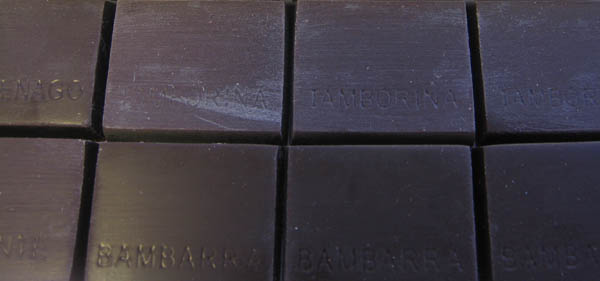
In Noka Part 3, we established that, contrary to a widespread misperception seemingly encouraged by Noka’s founders, the company does not source or process cacao beans. Onward…
So Noka doesn’t make chocolate. There’s no shame in that, since the same can be said of the vast majority of chocolatiers. However, the vast majority of chocolatiers are not giving the public the impression that they are chocolate makers, nor are they charging hundreds or even thousands of dollars per pound for their product. Knowing what Noka actually does (and doesn’t do) is a necessary prerequisite to evaluating the value of the product.
And what does Noka do? In the case of their chocolate tablets (or “Vintages”), they buy blocks of chocolate from Europe, melt it, temper it, and pour it into small rectangular molds. It’s as simple as that. As Chloé Doutre-Roussel wrote in The Chocolate Connoisseur, “If they just melt a readymade couverture (as many do), there’s no need for talent or creativity.” Despite the limited ambition of their molded chocolates, the quality of their work is frustratingly inconsistent. In the boxes I’ve purchased (all locally, so no shipping was involved), I’ve occasionally found an unacceptably dull finish or even bloom on their molded chocolates (as pictured at the top of this article).
As for the truffles, Noka buys the chocolate, melts some of it and mixes it with cream to form a ganache, pipes the ganache in thimble-sized lumps on parchment paper, enrobes the lumps with tempered chocolate, then sprinkles some shaved chocolate on top. They’re as basic a truffle as you’re likely to find anywhere—well within the capability of amateurs at home. The truffles appear to be either dipped or mechanically enrobed, and show no signs of the hand-rolling one would reasonably expect given the price point. The ganache is often dense and fudgy, sacrificing texture for, I suppose, a darker chocolate flavor.
In an online interview with Lisa Dial of Wisewomen Radio, Merrem made it sound as though there’s more to Noka’s technique. When asked how she learned her craft, Merrem replied, “A lot of reading in older text books and things, because what we do is a very, very old style approach to chocolate with not having any additives or preservatives; and so most of what’s out there today is very geared to modern day chocolate which really wasn’t applicable to what we are doing.”
If Merrem was unable to find instruction on how to temper and mold chocolates or make basic truffles in contemporary cookbooks, she must not have looked very hard. Sure, it can be found in professional-oriented works such as Bo Friberg’s The Professional Pastry Chef or Jean-Pierre Wybauw’s Fine Chocolates: Great Experience. But everything you need to know to mold chocolates and make simple truffles (i.e., ingredients: dark chocolate and cream) can be found on pages 849 and 850 of The Joy of Cooking. Not exactly the Grand Arcanum.
To recap, the folks at Noka are not “chocolate makers.” Though the quality of the couverture they buy is quite nice (and we’ll be taking a closer look at that in the coming reports), their work as chocolatiers is rather rudimental. To get a sense of what I mean by “rudimental,” take a look at Noka’s chocolates, then compare them with those of, say, Michael Recchiuti, Norman Love, La Maison du Chocolat, Michel Cluizel, or Fritz Knipschildt. Compared with true professionals, Noka’s work looks like that of school children.
